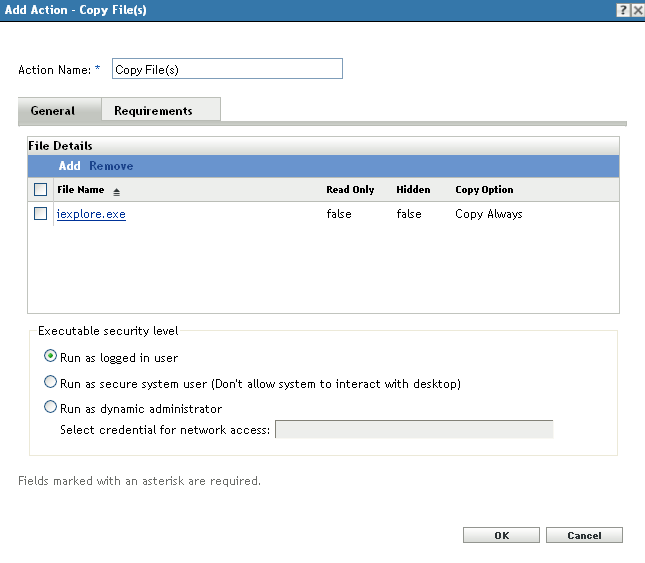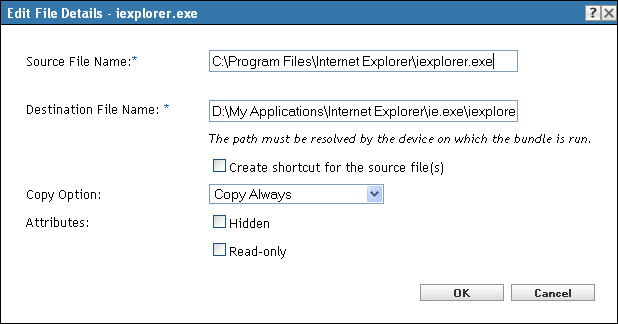6.3 Action - Copy Files
The Action - Copy Files dialog box lets you specify files to copy to the device and the specific requirements that a device must meet for the action to be executed on the device.
Figure 6-3 Action - Copy Files Dialog Box

You can access this information by using the following methods:
-
As part of the process of creating a Windows bundle by using the bundle category. For more information, see Section 2.4, Creating Windows Bundles.
-
In ZENworks Control Center, click the tab, click the underlined link of a bundle in the column of the list, click the tab, click one of the action set tabs (Distribute, Install, Launch, Verify, Uninstall, Terminate, or Preboot), click the drop-down list, then select an available action.
The following sections contains additional information:
6.3.1 General
The General page lets you specify the files to copy to the device and the executable security level.
File Details
Click to display the Select Files dialog box. Click the button for more information.
Edit File Details
The Edit File Details dialog box page lets you specify a copy option, the complete path of the source file to be copied, the path of the destination file, and whether the file is hidden or read-only after being copied to the device. Click any of the file names in the File Details dialog box to go to the Edit File Details dialog box.
Figure 6-4 Action - Edit File Details Dialog Box

Renaming the source file: To copy the source file to the destination directory with a different name, specify the new name along with the destination path in the field in the Edit File Details dialog box.
For example, to copy run.exe from C:\Program Files\Internet Explorer\ to D:\My Applications\Internet Explorer\ie.exe,use ie.exe as the new name you specify in the field in the Edit File Details dialog box.
Copy Option: Select a copy option from the list. For details, see Copy Option in the Action - Copy Directory section.
Attributes: Select one or more of the following attributes:
-
Hidden: Select the Hidden check box to specify that the directory is hidden after being copied.
-
Read-only: Select the Read-only check box to specify that the directory is read-only after being copied.
Executable Security Level
On Windows 2000, Windows XP, Windows Vista, or Windows 7 device, the application executable can run in either the “user” space or the “system” space. By default, the option is selected, which causes the application to run in the “user” space and inherit the same workstation security level as the logged-in user.
If the logged-in user's security level does not provide sufficient rights and file access to run the application, you can configure the application to run in the “system” space or as a dynamic administrator, as described below:
Run as logged in user: The action uses the logged-in user’s credentials. For example, the action has the same rights to the registry and the file system as the logged-in user.
Run as secure system user (Don't allow system to interact with desktop): The application is run under the Local System user and inherits Administrator-level credentials. For example, the application has full rights to the registry and the file system. Because the security level is set to , the application's interface is not displayed to the user and the application is only visible in the Task Manager. This option is useful when running applications that require full access to the workstation but require no user intervention. If you use mapped network drives to specify files and directories, the action fails because system users do not have access to user mapped drives.
Run as dynamic administrator: A dynamic administrator is an administrator account that is created on the fly to perform certain procedures, such as installing applications. Using a dynamic administrator is helpful when installing applications (some MSI applications, for example) that cannot be installed in the system space. When you select this action, the dynamic administrator is created, it performs the required tasks, and then the account is deleted.
You cannot use mapped network drives to specify files and directories because dynamic administrators do not have access to mapped drives.
Select credential for network access: If the file or directory specified in the action are a part of the UNC path or network share that can be accessed only through credentials, then browse through the credential vault to select a credential that has access to the network.
NOTE:ZENworks does not support Windows Distributed File System (DFS) share.
For more information on Credential Vault and adding credential to the Credential Vault, see Using the Credential Vault
in the ZENworks 11 SP3 ZENworks Control Center Reference.
NOTE:Performing this action as dynamic administrator on a Windows domain controller fails because Microsoft does not allow the use of local administrator accounts on domain controllers.
6.3.2 Requirements
The Requirements page lets you define specific requirements that a device must meet for the action to be enforced on it. For information about the requirements, see Requirements.